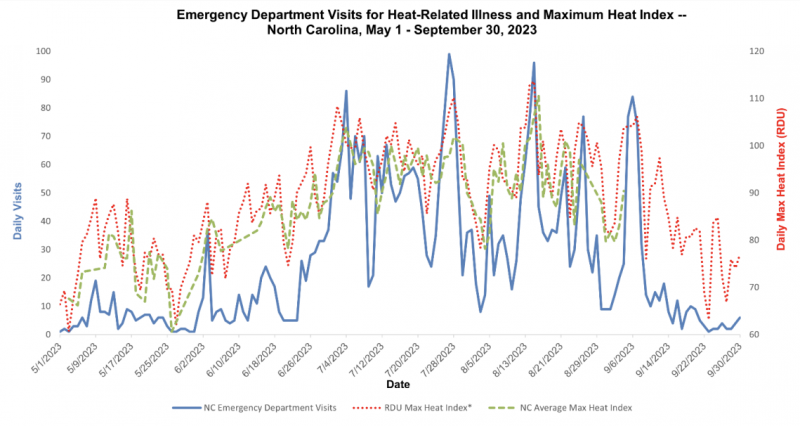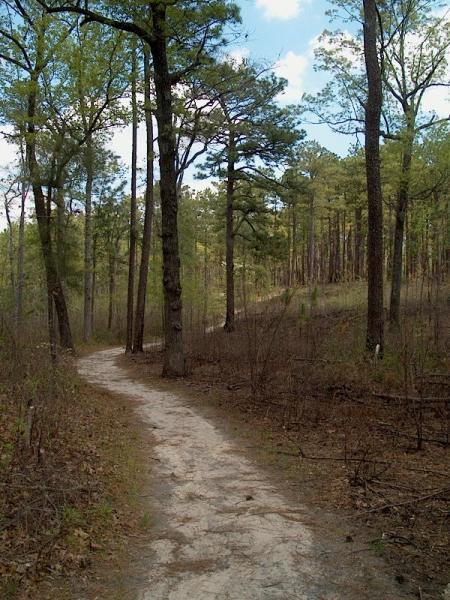Higher temperatures put North Carolina’s residents at risk
North Carolina’s 2020 Climate Science Report projects that extreme heat events will increase in the state. In coming decades, temperatures are projected to reach 95°F more frequently. Accompanied by an increase in humidity, the "feels like" temperatures people experience will feel even hotter. Many residents feel they are used to dealing with heat, so they may not recognize how heat stress can sneak up on a person. Visits to emergency departments for heat-related illnesses surged to almost 4,000 individuals during the 2023 heat season; this number highlights the need for more North Carolinians to understand what they can do to protect themselves.
Focusing in on the Sandhills
The Climate and Health Team at North Carolina's Department of Health and Human Services looked at data on heat illness across the state. They recognized that people in the Sandhills region are especially vulnerable to the negative health impacts of heat: the region has a high poverty rate, a large number of individuals with underlying health conditions, and a higher number of migrant farmworkers than other parts of the state. As the region is mostly rural, cooling centers and other resources are generally less accessible than in urban areas. Counties in the Sandhills are also expected to experience more extreme heat days per year than any other part of the state. Research at the University of North Carolina shows that counties in the Sandhills already have the highest rates of heat related illness in the state.
Recognizing the Sandhills population's susceptibility to health consequences from increasing heat, the Climate and Health Team wanted to further understand the lived experience of those who are most vulnerable to this new reality by hearing directly from communities.
Understanding community perspectives on heat impacts
Department personnel conducted interviews with partners in Bladen, Robeson, Sampson, and Scotland counties to understand their experience and heat safety programming needs. The interviews confirmed what the team was seeing in the data: outdoor workers, people living in poverty, older adults, and young children were at a higher risk of heat-related illness. In addition, the team saw that lack of transportation and air conditioning were significant factors that limited communities’ ability to adapt to extreme heat events. This lack also affects many migrant farmworkers, who are regularly exposed to high heat.
“People get a lot of direct exposure [to heat] on the job… but many homes lack efficient cooling systems”. – Community member
Community leaders in these interviews emphasized the need for education about extreme heat and heat-related illness in the Sandhills to make sure people were informed of their risk and new how to manage the new level of heat.
“Access to information would make a huge difference. We need to meet people where they are at”. – Community leader
Spreading Community Awareness of Heat Risks
As a result of these interviews, the team convened a Climate Resilience Taskforce specific to the region and charged them to provide heat health services, resources, and education in the Sandhills. To broaden their education efforts, the Climate and Health team and the Taskforce created and distributed multilingual materials to communicate crucial heat relief information. They also developed a train-the-trainer heat-health curriculum for the Taskforce to use during outreach to prevent heat-related illness.
These educational materials are now being used as part of the Heat Health Alert System that occurs each summer. First implemented in 2018, the alert systme has already evolved, but it retains the goal of alerting individuals and partners to dangerous levels of heat to they can take protective measures. The Taskforce further disseminates alerts through social media, e-mail, and other mechanisms to front-line communities.
Experiencing heat stress firsthand
Kathie Cox, a heat-health educator in Scotland County and a member of the Taskforce, learned first-hand about heat stress.
During a hot summer day, Kathie returned home from her routine exercise and walking her dog, and she decided to mow her lawn. When she was done mowing, she started to experience common symptoms of heat exhaustion: heavy sweating, pale and clammy skin, weakness, and nausea. As her symptoms worsened, she called her daughter for help. Because she recognized her symptoms as heat exhaustion, she was able to take measures to cool her body and recover without a trip to the hospital. She admits that even though she knew better, she had not taken appropriate breaks and precautions for physical exertion in the heat. This experience is not unique to Kathie; many people feel they are used to heat and don’t need to take precautions.
This personal incident reaffirmed Kathie’s commitment to educating the Sandhills community on safety precautions around heat. She shares this story widely to continue raising awareness of the risks of extreme heat and encourages others to protect themselves.
Looking forward
Sharing personal experiences, awareness, and education from community members has been the key to building resilience to the health effects of heat in the hardest hit communities. As the North Carolina summers grow hotter and the risk of extreme heat events increases, the Climate and Health Program will build on their efforts in the Sandhills to provide critical resources to all North Carolinians, in addition to providing targeted resources to populations hit hardest by heat.
In 2024, the program plans to make the Heat Health Alert System available statewide. They'll use this system to help raise awareness of heat-related illness and what peole can do do to stay safe. They'll also increase engagement to help protect farmworkers in the Sandhills. At the same time, Kathie will continue to share her story, to inform and protect the communities she serves from increasing episodes of extreme heat.



